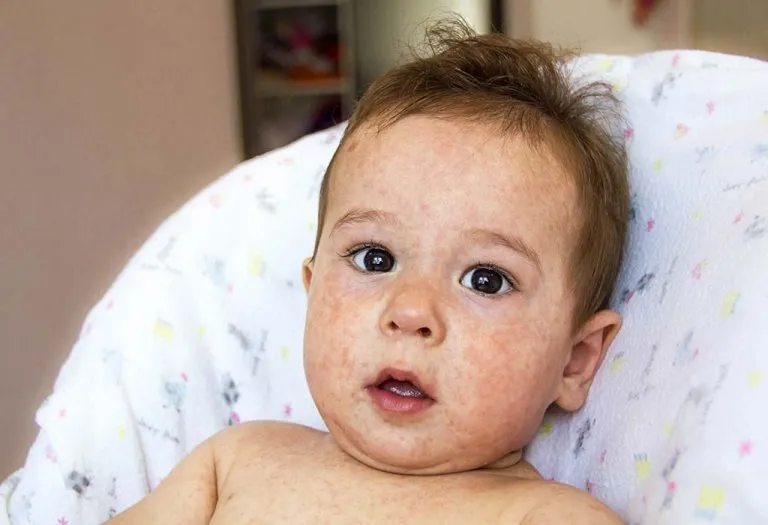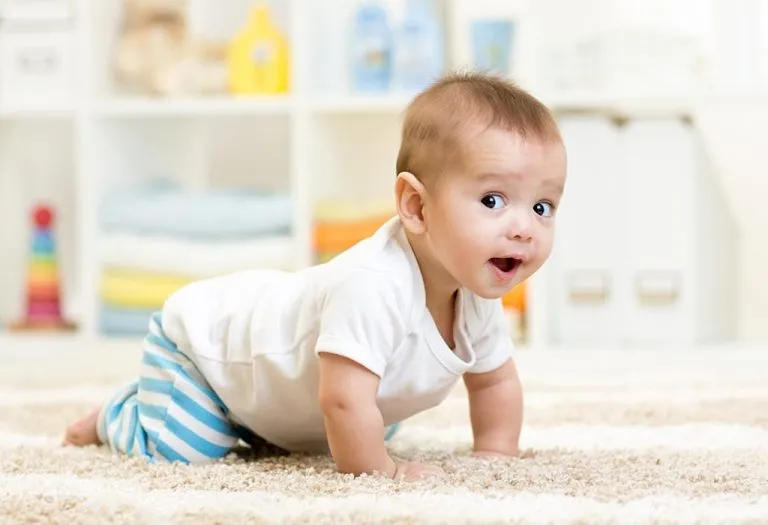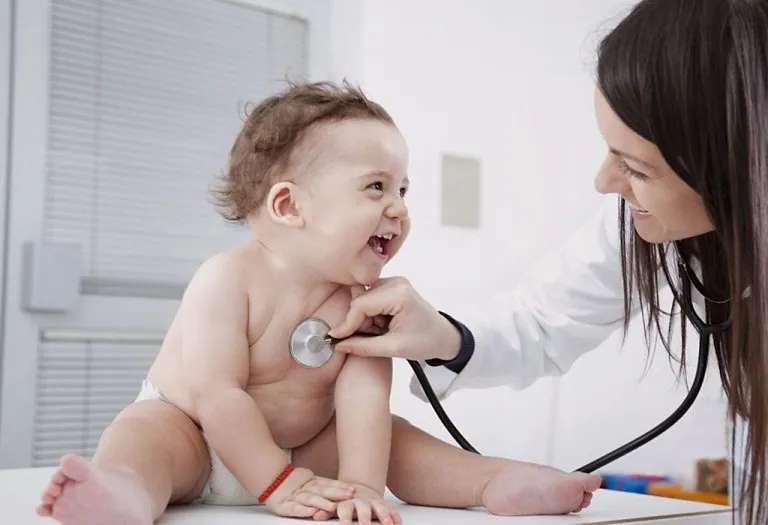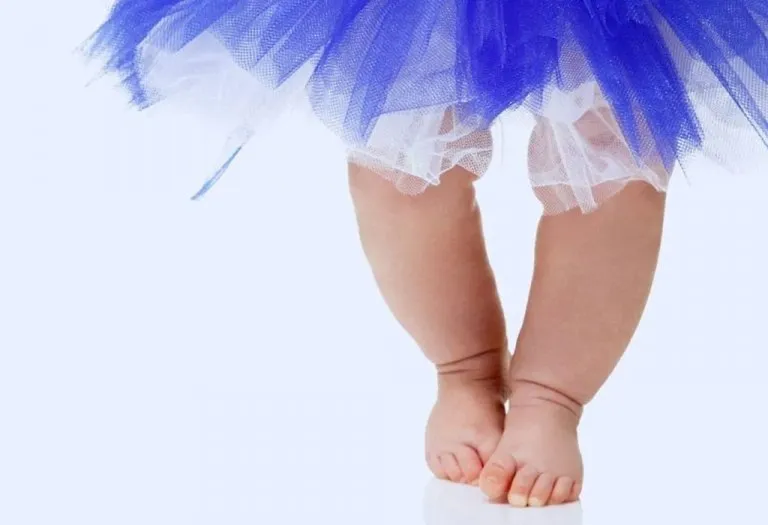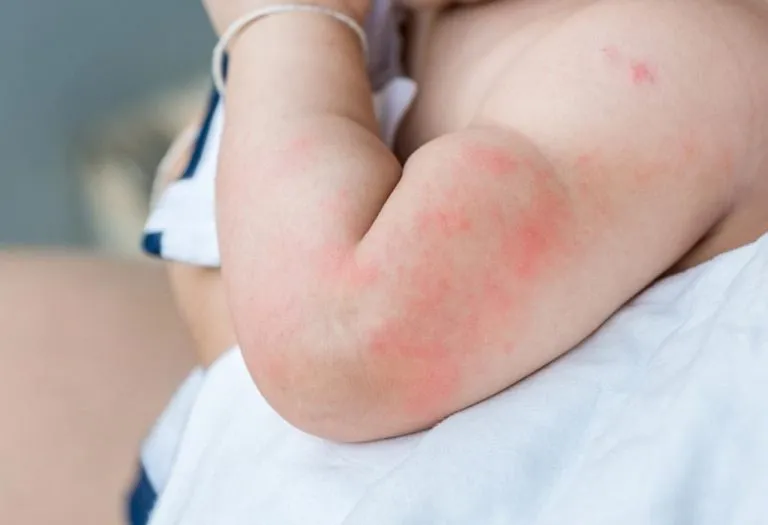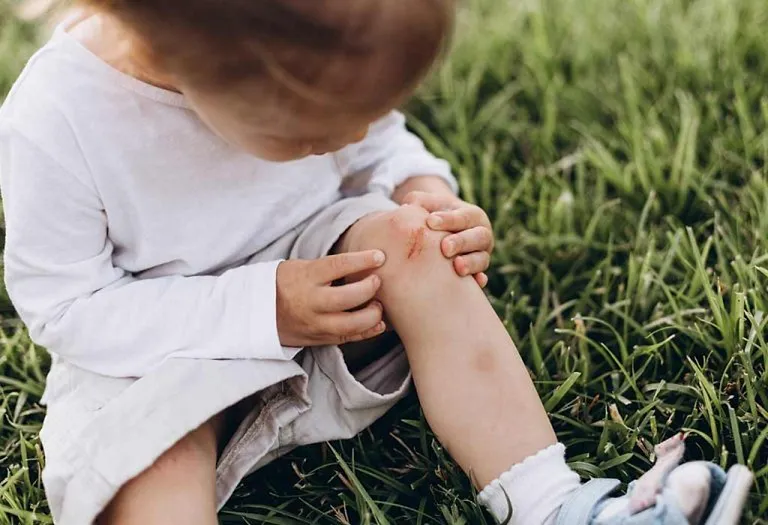Does Skin Discolouration in Babies Signal a Serious Problem?

- What Causes Skin Discolouration in Infants?
- Treatment for Discolouration of Baby Skin
- Home Remedies for Baby Skin discolouration
- When to Consult a Doctor?
- FAQs
For new parents, nothing is more precious than their little one. It is quite natural to dote over them and keep a close eye on every minute change—from the growth of their tiny limbs to their first fingernails, their first steps, and even the addition of a new hair on their little head—parents tend to notice everything!
Unsurprisingly, observing an infant’s skin colour change can cause parents to worry excessively. Newborn babies have highly sensitive skin, making them susceptible to the slightest changes around them. As a result, their bodies can exhibit numerous glaring signs. It is important to note what causes skin discolouration in newborns and whether medical intervention is required to correct it.
What Causes Skin Discolouration in Infants?
To determine whether your child has infant eczema skin discolouration or anything else similar, it is essential to know the various causes that can cause baby skin discolouration. Some of these are condition-based, while others might tend to be present right from the child’s birth.
1. Strawberry Nevus
As sweet as the name sounds, the condition can shock most parents. In some babies, the blood vessels collect together tightly in a particular area and cause red-coloured patches to emerge in that region. This is no different from a birthmark and is usually spotted in babies right after birth. These are entirely harmless and might fade away or grow darker with time (1).
Symptoms
A red or blue-coloured discolouration in a small region of the butt, face, stomach, back, and so on. The marks could be on a separate layer of the skin as well.
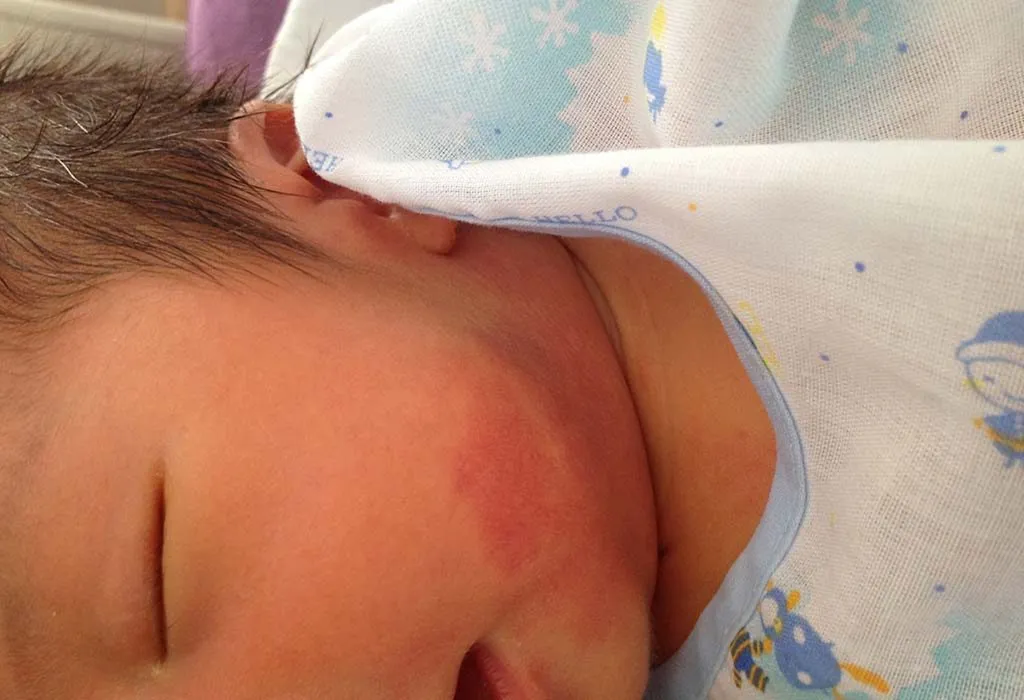
2. Eczema
Eczema is a prevalent skin condition observed in adults and babies. It primarily causes skin discolouration. Eczema is usually triggered when a baby’s sensitive skin comes into contact with any substance that triggers an allergy. At times, it could result from oral intake or even the presence of dehydrated skin that leads to an eczema-like condition (2).
Symptoms
Itching in various body areas combined with red-coloured bumps on the chest, arms, and other body regions (2).
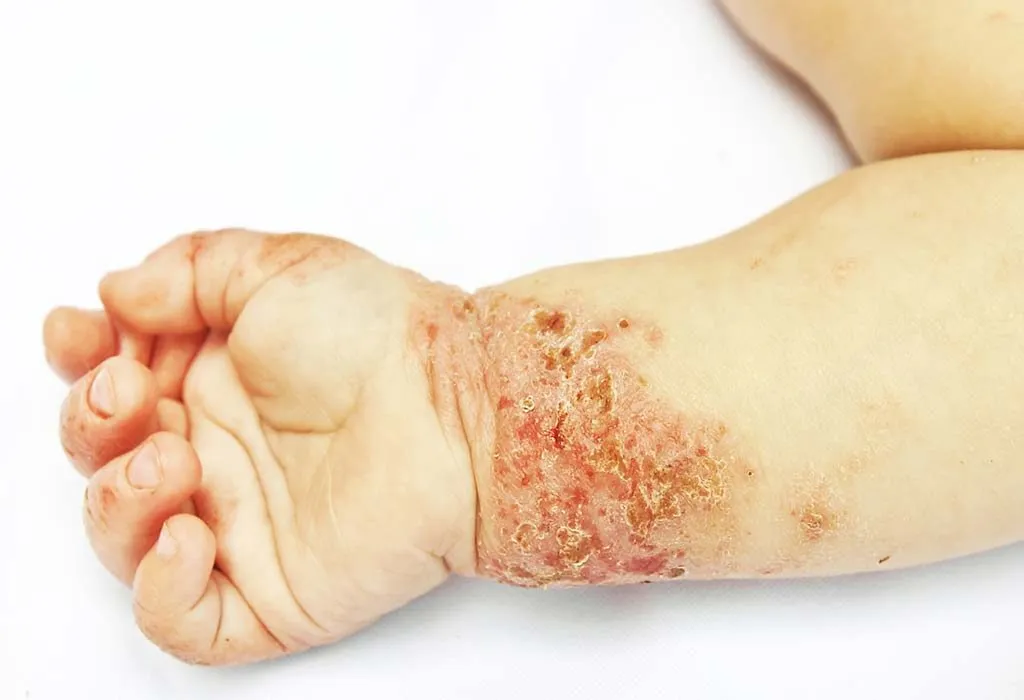
3. Infant Rash
A specific type of rash observed in newborns is also a reason behind an infant’s skin discolouration. Generally termed erythema toxicum, or baby acne, this rash is known to show up right after birth and continues for about 12-15 weeks. Although the cause is unknown, it is believed to result from certain hormones transferred from the mother (3).
Symptoms
Tiny pimples with a yellow or white coloured centre that are hard and dry, occurring on the nose, chest, back, and other regions of the body (4).
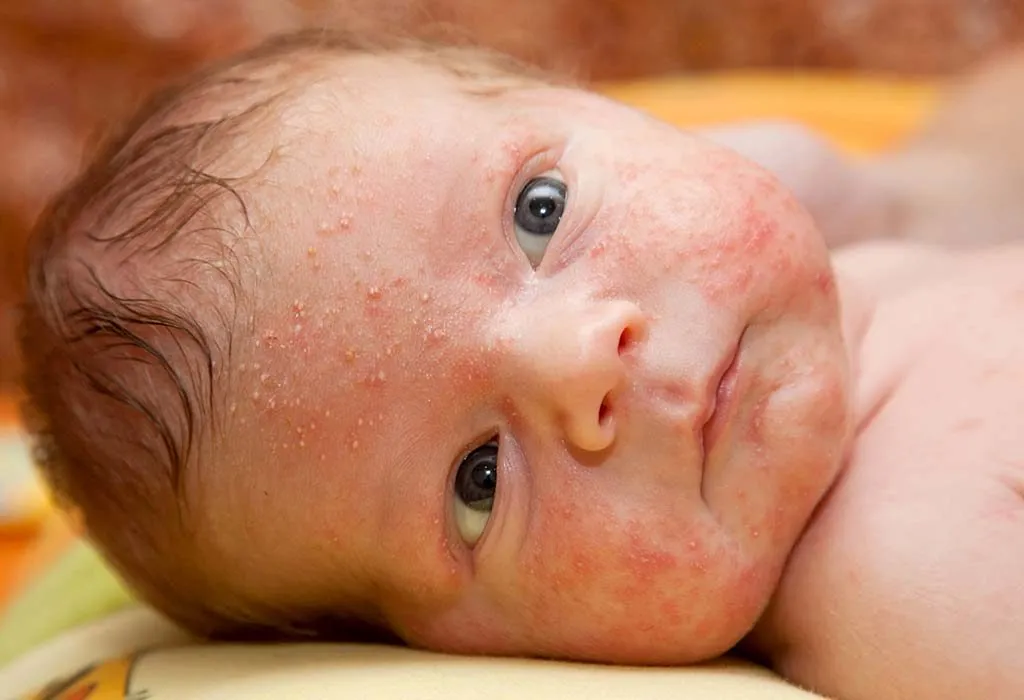
4. Hives
Many parents are aware of hives, while some might have experienced them. A hive is a red-coloured rash slightly raised atop the skin and spreads rapidly around the body. It is nothing but the body’s immunity reaction against the presence of an allergic substance. Anything from foods to creams and smells can trigger hives (5).
Symptoms
Welts or bright red spots on the skin, combined with fever, cough, blocked nose and diarrhoea (6).
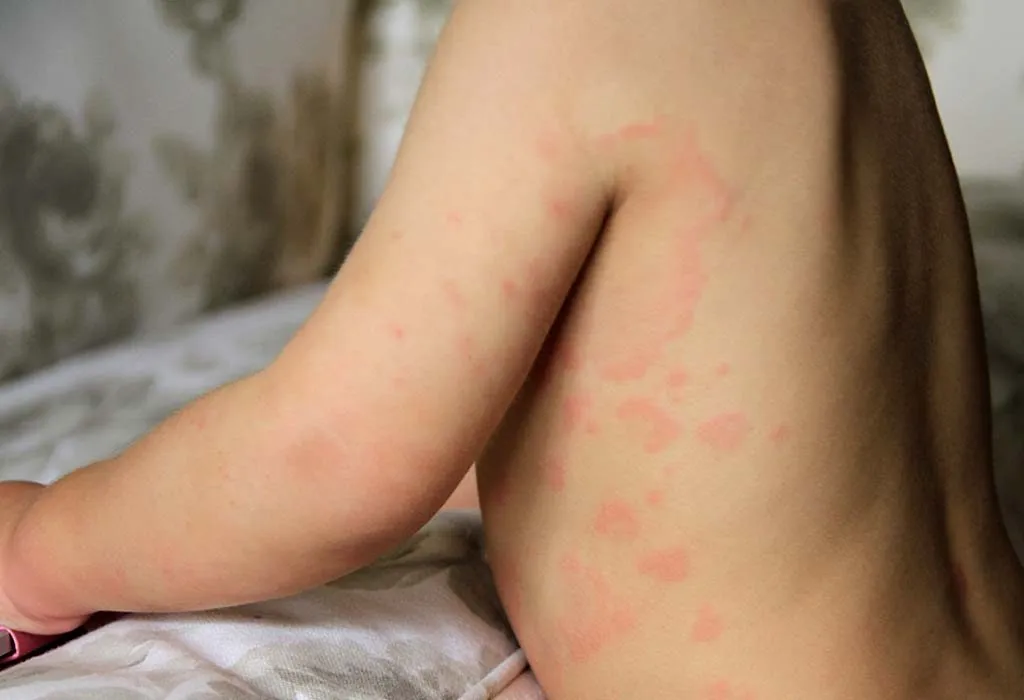
5. Ringworm Infection
The sensitive nature of a baby’s skin puts it at higher risk of infection by various microbes and fungi. Skin discolouration due to the ringworm fungi is pretty typical and usually occurs if a baby sweats a lot or wears wet diapers, which leave the skin warm and moist (7).
Symptoms
Most skin discolouration occurs in itchy red patches, which can even cause pain. Sometimes, a white fluid oozes from the skin and smells like a yeast infection.
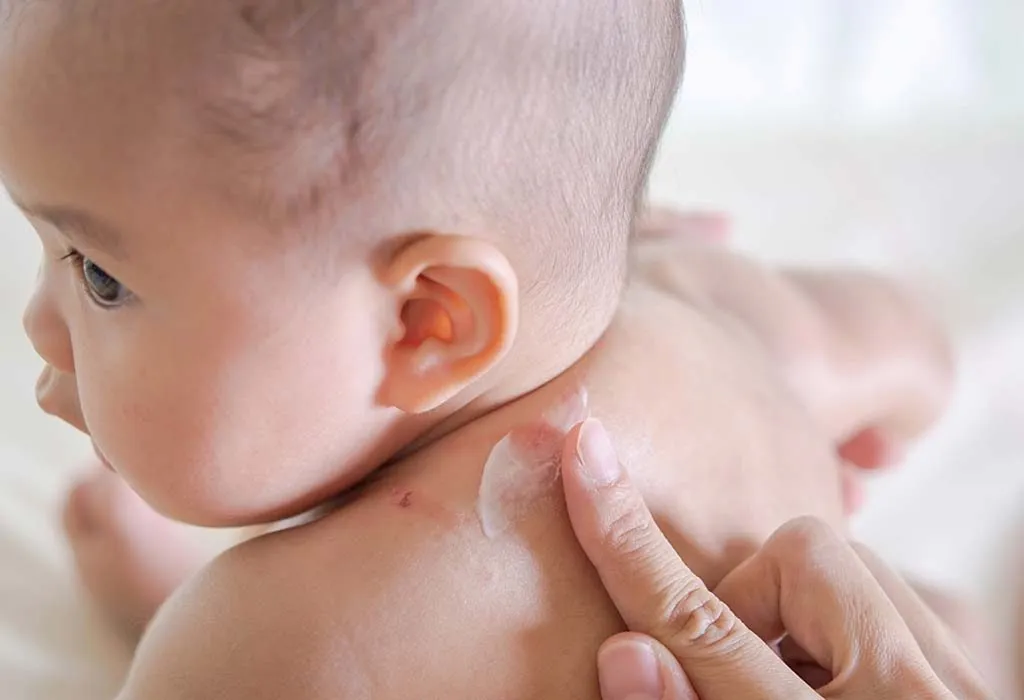
6. Mottling
Mottling is a skin discolouration that can make your baby’s skin look disturbing. The patterns on the skin’s surface result from reduced blood flow in the upper layers, which is caused by the baby being colder than usual. Mottling is also observed in adults. It usually occurs if your child has a fever and the blood keeps the internal organs safe, reducing the supply to the skin (8).
Symptoms
The redness occurs in patchy circular patterns, sometimes making your baby resemble a marble statue (8). Veins might also be visible, causing a few areas to look whiter than usual.
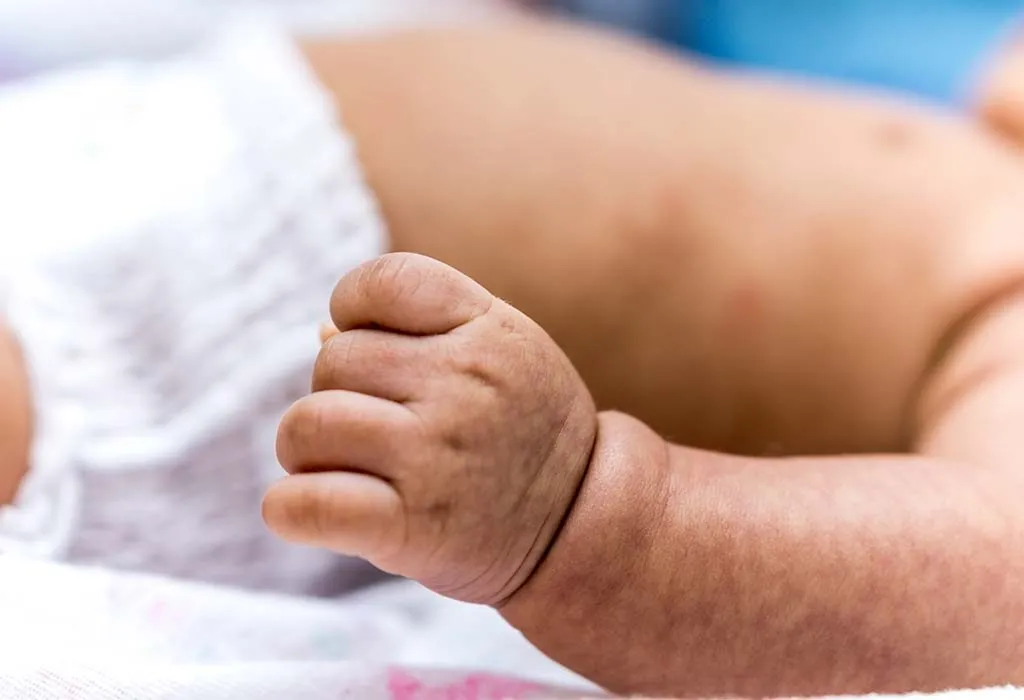
7. Acrocyanosis
While most skin conditions cause red colour patches or discolouration, acrocyanosis leads to a bluish tinge appearing on the skin. Mostly seen in babies in the first couple of days after birth, the condition is normal and results from the child’s circulatory system coming to terms with the increased demand. As the vessels dilate, the discolouration starts fading away (9).
Symptoms
The areas surrounding the face, lips, feet, and hands are bluish-purple (9).
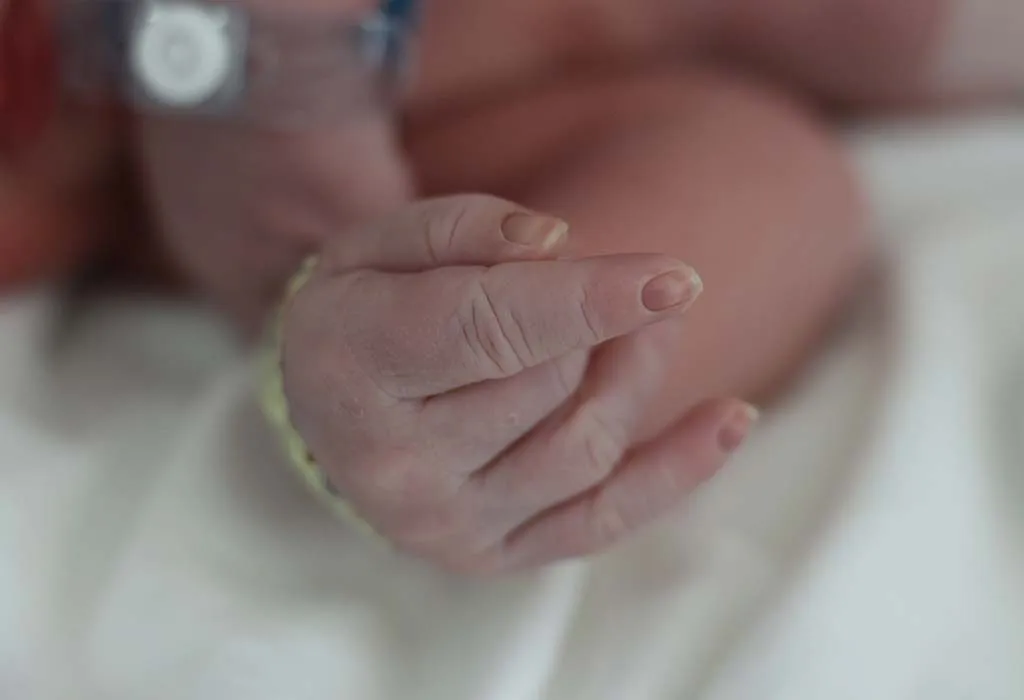
Treatment for Discolouration of Baby Skin
Most typical skin discolourations fade away naturally with minimal to zero intervention. A yellowish tinge might indicate jaundice and require medical attention. Extreme conditions of acrocyanosis or skin discolouration combined with physical disfigurement might require surgery or strong medication.
Home Remedies for Baby Skin discolouration
Parents often look for natural ways to remedy skin discolouration in babies, irrespective of the location affected. Several techniques can help relieve the discolouration if it irritates the baby and helps it fade away.
1. Adjusting the Diet
At times, skin discolouration might result from the body reacting to a particular food item. This can be conclusively determined by examining specific food items and observing their reactions. It could sometimes be a sign of a lifelong allergy or even a temporary one.
2. Keeping the Baby Warm
Some children experience severe skin mottling after bathing or in the tub for long durations. In specific scenarios, the presence of cold water or a cold atmosphere can cause the skin to react in such a manner as well. Ensure your baby is warm and comfortable as often as possible, and bundle him up in a blanket if needed.
3. Staying Indoors
Your baby may have tinea versicolour, a harmless fungal infection leading to skin discolouration. The hot, humid climate is known to accelerate its growth. Hence, ensure your baby is wearing loose-fitting clothes and indoors during this time (10).
4. Opting for Organic and Healthy Products
The constitution of a baby care product might be why the little one’s skin reacts adversely. Using certain chemicals or fragrances to make the cream or shampoo better suited for kids could trigger a reaction in the child’s sensitive skin for a different brand or an organic equivalent or even homemade creams for a while (10).
5. Constant Warmth to Tackle Acrocyanosis
The presence of a purplish tinge on the hands or feet of the baby might be indicative of acrocyanosis. Blood vessel constriction usually causes this, and if the child’s body is cold or exposed to cool atmospheres, the condition may worsen. Therefore, gloves and socks can help the body balance properly (11).
6. Honey
One well-known home remedy for skin discolouration is honey, which can be used as a bleaching agent. Apply some honey to the affected area for about 15 minutes daily, and you will surely see a reduction in the discolouration (12).
When to Consult a Doctor?
If you notice any of the following in your baby, it is best to consult your doctor to deal with something that could be a skin discolouration or something more serious:
- If your baby suddenly turns red or raised welts appear on their body, it could indicate an allergic reaction. Consult your doctor immediately for more advice on the dosage of antihistamines required.
- If your baby suddenly turns blue, rush them to the nearest hospital or call emergency services
FAQs
1. Can babies be hyperpigmented?
Birthmarks mark hyperpigmentation, more or larger patches of darker skin, which is generally benign and not a cause for concern. However, consult your physician immediately if you notice skin colouration changing rapidly.
2. Does breast milk affect a toddler’s skin colour?
No, your little one’s skin colour is genetic and changes due to environmental and immunity factors. However, your breast milk contains nutrients that promote healthier skin in your baby!
3. When should I be worried about my baby’s skin discolouration?
If your baby’s skin discolouration evolves, changes or spreads rapidly, it might be a cause for concern. Additionally, consult emergency services immediately if it is accompanied by diarrhoea, fever, vomiting, red welts, cough, itching, and swelling.
4. When will my baby get their final skin colour?
While the parents’ genetics play a huge role in your baby’s skin tone, the melanin in their skin (which is responsible for their skin tone) continues to evolve after birth. This means that your baby’s skin tone will fully develop between six months to 1 year after birth.
Remedying skin discolouration in a newborn baby is not difficult since most of them are signs of the body coming to terms with the new environment. Your doctor’s advice is instrumental in understanding how to correct the discolouration, and natural remedies are always recommended before opting for medication.
References/Resources:
1. Strawberry Hemangiomas; Cleveland Clinic; https://my.clevelandclinic.org/health/diseases/21568-strawberry-hemangiomas
2. Baby Eczema; Cleveland Clinic; https://my.clevelandclinic.org/health/diseases/23408-baby-eczema
3. IS THAT ACNE ON MY BABY’S FACE?; American Academy of Dermatology Association; https://www.aad.org/public/diseases/acne/really-acne/baby-acne
4. Baby Acne; Mayo Clinic; https://www.mayoclinic.org/diseases-conditions/baby-acne/symptoms-causes/syc-20369880
5. Hives; American College of Allergy, Asthma, and Immunology; https://acaai.org/allergies/allergic-conditions/skin-allergy/hives/
6. Hives; Seattle Children’s Hospital; https://www.seattlechildrens.org/conditions/a-z/hives/
7. Ringworm in Children; Cedars Sinai; https://www.cedars-sinai.org/health-library/diseases-and-conditions—pediatrics/r/ringworm-in-children.html
8. Skin Colour Changes in Newborn; Saint Luke’s; https://www.saintlukeskc.org/health-library/skin-color-changes-newborn
9. What is Cyanosis in Infants and Children?; Cincinnati Children’s https://www.cincinnatichildrens.org/health/c/cyanosis
10. Newborn Skin 101; Johns Hopkins Hospital; https://www.hopkinsmedicine.org/health/wellness-and-prevention/newborn-skin-101
11. Acrocyanosis; Cleveland Clinic; https://my.clevelandclinic.org/health/diseases/acrocyanosis
Also Read:
Infant Skin Care Ritual
Tips to Take Care of Baby Skin
How to Take Care your Baby’s Skin
Was This Article Helpful?
Parenting is a huge responsibility, for you as a caregiver, but also for us as a parenting content platform. We understand that and take our responsibility of creating credible content seriously. FirstCry Parenting articles are written and published only after extensive research using factually sound references to deliver quality content that is accurate, validated by experts, and completely reliable. To understand how we go about creating content that is credible, read our editorial policy here.







